The G.R.O.W. Coaching Model in Leadership: Part Three

In the photo above, obstacles to urban farming might include the lack of a water tap, site security, experience of volunteers, and identifying project leadership. In this location, OSU Extension educators helped identify some options to surmount the obstacles of starting an urban farm in Cleveland, Ohio. (Imagine one of your students, colleagues, or mentees asking for your help on their own project or idea’s obstacles.)
As we begin to understand the goals and reality of the people we’re coaching, we next must look at the OBSTACLES which may be in the way, and the OPTIONS that may be available to move forward.
As a quick reminder, here are the G.R.O.W. questions we are working through:
Goal: What do you want to achieve?
Reality: What/where are you now?
Obstacles/Options: What is in your way? What are the options?
Way Forward: What are the next steps to move forward?
Let’s begin with what’s standing in the way. We often find obstacles in four distinct areas:
- The person himself/herself: Are they holding themselves back somehow?
- Other people: Are teammates or coworkers reining them in? Has their boss given them so much busy work that their talent can’t shine through?
- Lack of skills, knowledge or experience: Could they excel if they simply had some training?
- Physical environment: Is there a structural or physical impediment?
Your goal here is to help them identify those obstacles and then assist them in thinking through options to resolve the issues. But remember, it’s not up to you to provide the answers. Instead, ask questions to spur their thinking, reflection, and discovery.
Use the “fold your hands / arms” exercise again. Create some cognitive dissonance. Disrupt their normal thinking to discover new paths around whatever the obstacles may be.
A coach does all he or she can to draw the options from the person. Your job in working with them is to facilitate the process. This will result in more direct and specific responses that will provide better solutions in the long-term.
In the final post, I’ll describe the final step: the way forward . . .


